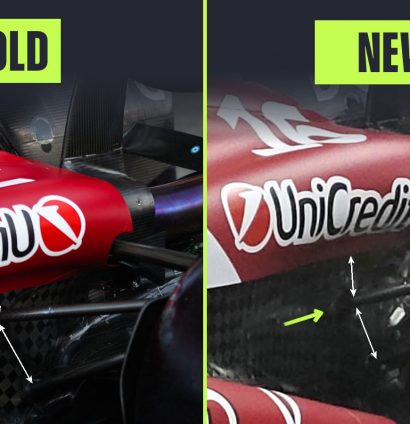George Russell theory branded ‘crazy’ as big Ferrari mystery thickens

George Russell raised eyebrows with his comments about Ferrari's loss of pace in Hungary
George Russell’s theory that raised tyre pressures caused Ferrari driver Charles Leclerc’s dramatic loss of pace in Hungary is “a bit wacky and far-fetched.”
That is the claim of former F1 technical director Gary Anderson, who says there are “better and less dramatic solutions” to guard against excessive plank wear on F1 cars.
George Russell’s Ferrari theory ‘a bit wacky and far-fetched’
Ferrari has been battling a problem with the SF-25’s ride height since the start of the F1 2025 season, with the issue first identified at the season-opening Australian Grand Prix in March.
The problem came to a head a week later in China, where Leclerc’s team-mate Lewis Hamilton was disqualified for excessive skid-block wear just 24 hours after dominating the sprint race in Shanghai. Leclerc himself was also disqualified after his car was found to be underweight.
Fred Vasseur, the Ferrari team principal, admitted for the first time earlier this week that the Scuderia has been forced to leave a “safety margin” with the car’s ride height in the months since the Chinese Grand Prix in a bid to avoid a repeat.
George Russell closing in on new Mercedes contract for F1 2026 and beyond
👉 George Russell set to sign multi-year contract extension with Mercedes
👉 F1 driver contracts: What is the contract status of every driver on the F1 2025 grid?
It emerged after the Austrian Grand Prix that Ferrari has been instructing Leclerc and Hamilton to lift and coast at the end of straights to stop the floor being dragged along the track surface at maximum load.
It was hoped that a major rear-suspension upgrade introduced at last month’s Belgian Grand Prix (below) would go some way to rectifying the SF-25’s ride-height issues.

Yet after claiming the team’s first pole position of the season and dominating the first half of the race, Leclerc suffered a mysterious loss of pace in the final stint in Hungary, ultimately finishing a distant fourth.
Russell claimed after the race in Budapest that Ferrari may have been forced to increase Leclerc’s tyre pressures and turn to a more conservative engine setting for the last stint in order to protect the skid blocks.
The Mercedes driver added that Leclerc’s car was “close to being illegal” before the desperate measures were introduced for the final stint of the race.
Writing in a column for the Telegraph, former Jordan technical boss Anderson has dismissed Russell’s claims, pointing out that there are more efficient methods for teams to manage plank-wear concerns.
Anderson said: “What Russell suggested is a bit wacky and far-fetched in my opinion.
“A team would not reduce performance in this way just to stop plank wear. There are numerous other, better and less dramatic solutions.
“Firstly, you would change the setup of the car, running the rear of the car stiffer or raising the ride height slightly to reduce plank wear.
“Yes, there will be a performance loss but not to the extent we saw after his last stop.
“When it comes to tyre pressures, again, it seems unlikely.
“If you put the rear tyre pressures up you are guaranteed to lose performance from the rear tyres overheating.
“Doing this on a track where traction is absolutely critical is crazy.
“As we have seen in the past, Ferrari make some strange decisions but I do not for one second think that Russell is on to anything here.
“These changes are too much of a compromise.”
He added: “Something obviously happened with the car and it is not about engine mode or tyre pressure.
“It is clearly a bit borderline and it might be the same thing that has been hurting Hamilton.
“Leclerc said it was an unspecified chassis problem after the race. Something can break or stop working correctly on a car, yes, but that happens once in a blue moon.
“It’s impossible to know what this was without further information from Ferrari.”
Speaking to media including PlanetF1.com after the race in Hungary, Vasseur confirmed that Ferrari would hold an investigation to identify the cause of Leclerc’s disastrous final stint.
The team’s findings are yet to made made public, with Leclerc and Ferrari expected to be quizzed on the matter when the F1 2025 season resumes at next weekend’s Dutch Grand Prix at Zandvoort.
Vasseur said: “It’s true that the situation was quite strange.
“We were under control the first 40 laps of the of the race. We were very in control in the first stint. The second one was a bit more difficult, but it was still manageable.
“And last stint was a disaster: very difficult to drive, the balance was not there.
“Honestly, we don’t know exactly what’s happened so far. I think that we have to investigate if something was broken on the chassis side or whatever.
“It’s really frustrating for us because I think we did the first pole position of the season, the first two stints going pretty well and we lost completely the pace of the weekend in the last one.”
Asked if the issue that affected Leclerc in Hungary was different to previous instances of Ferrari losing pace mid-race, he added: “Yeah.
“[On previous occasions] once we lost the pace, we lost two or three tenths.
“[In Hungary] we lost two seconds. It’s a bit different.”
Read next: Uncovered: The eye-watering costs behind creating an F1 team





